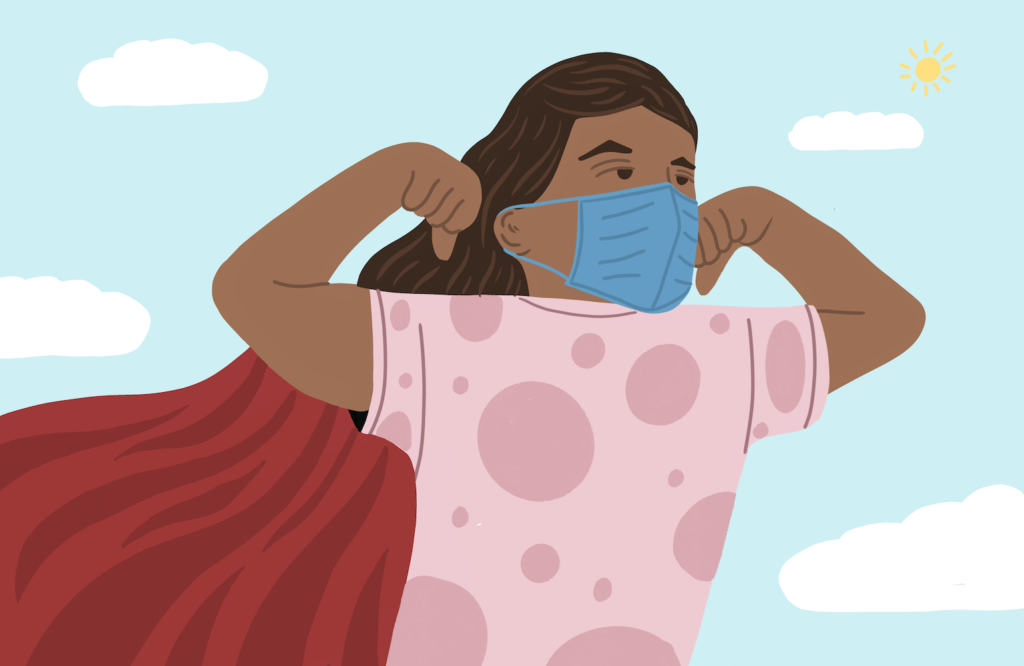Article originally published on Parents.com on July 14, 2020
Living in Hong Kong with me during the SARS outbreaks, my kids felt empowered wearing masks. The reason? We encouraged them to look at it is as their superpower.
My children spent many of their early years in Asia. Due to my work, we lived in Hong Kong during the SARS outbreak in the early 2000s and masks were a staple of daily life. Truth is, wearing masks was already pretty common in the region before the pandemic. Any given day, you’d see some adults out on the streets wearing them. And the same was true for kids. When children had a cough or felt ill, they would routinely ask the teacher for a mask to put on.
The thought process behind this was not about protecting themselves. Instead, it was about protecting others. Children in Asia tend to understand from an early age that anyone can spread an illness. They are taught to protect the people around them from whatever illness they might be coming down with.
With this altruistic view of mask-wearing in mind, children—including my own—felt good about wearing masks. As parents, we were able to present it as being their superpower. The message to our kids: You have the power to help prevent the spread of a virus. Putting on a mask means you’re doing something wonderful for your teachers, classmates, families, friends, the whole nation, and even the world. In other words, you’re like a superhero. Putting on a mask became fun, not frightening.
The Centers for Disease Control and Prevention (CDC) recommends “all people 2 years of age and older wear a cloth face covering in public settings and when around people who don’t live in your household” to help reduce the spread of COVID-19. And with many parents in America wondering how they can encourage their kids to wear masks if they have to go back to school in the fall—or whether or not they’ll be scared keeping one on all day—the superhero message is a great way to start.
“Empowering them to be a part of the solution during SARS added to their sense of identity and self-worth. It helped them take back the sense of power and control that the pandemic subsumed from them.”
In fact, researchers support the idea that this different way of looking at health precautions can help change how kids feel. “Framing social distancing as something your kids can do to help others empowers them to feel more in control of the situation,” licensed clinical psychologist Jenna Mendelson, Ph.D., writes for Cone Health, a healthcare delivery system based in Greensboro, North Carolina.
I saw all this play out for my children. Empowering them to be a part of the solution during SARS added to their sense of identity and self-worth. It helped them take back the sense of power and control that the pandemic subsumed from them.
It’s true that making these steps fun and playful can also make kids more eager to be health conscious. Children in China, for example, put together large, artistic hats to ensure social distancing when they returned to school in the spring after lockdown. I’m part of the SchoolMaskPack program to help make mask-wearing as joyful as possible. We created color-coded, washable masks for kids, parents, and teachers, along with a calendar card to keep track of which color mask to wear on which day.
But even amid the playfulness, it’s important that we make sure kids know the value of wearing masks goes far beyond them. It has ripple effects throughout their society and across the world. The more we all help our children adopt the mentality that we’re taking these steps not just for ourselves, but to protect those around us as well, the better off we’re going to be—both in terms of our health and in our relationships to one another.
Over the next couple of months, as some schools resume, we’ll have a chance to make this happen. If our kids go to school (or even if they are out in general), we can help them carry this crucial lesson with them: Not only do we need to keep life moving forward, but we also need to look out for each other. Every one of us can do our part. Ultimately, that’s how we’ll get through this pandemic.


